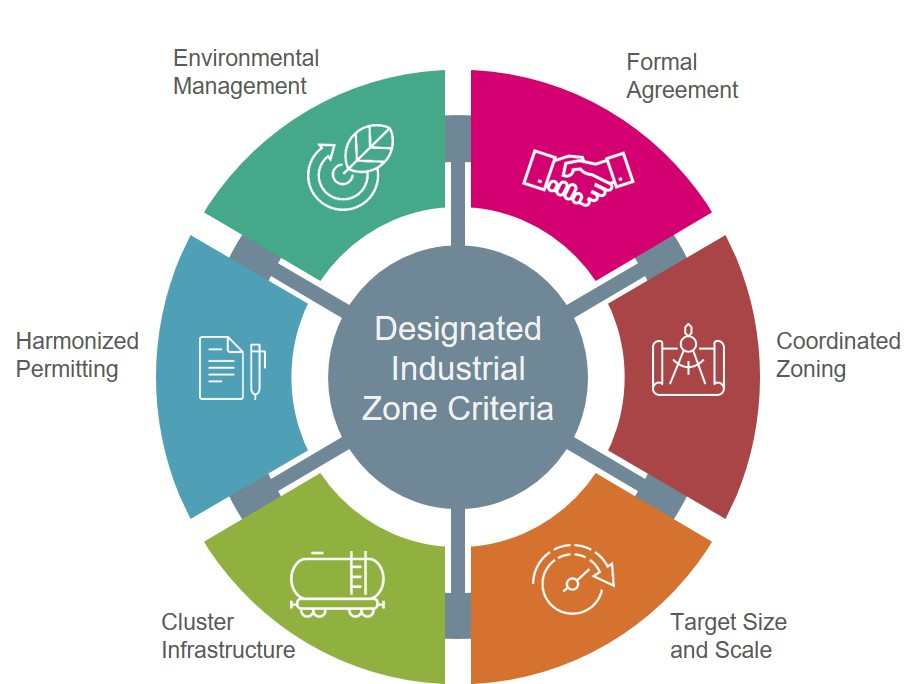Government mail service may be affected by the Canada Post labour disruption. Learn about how critical government mail will be handled.
Overview
The Designated Industrial Zone (DIZ) in Alberta’s Industrial Heartland will establish a best-in-class framework that will help attract new investment and create good jobs for Albertans while realizing environmental outcomes.
Facilities in the DIZ will benefit from:
- consistent, coordinated regulatory approvals
- shared access to infrastructure and resources
- minimized cumulative environmental impacts through participative governance of the zone and a commitment to continuous improvement
Designated Industrial Zones
There are 6 criteria required to designate an area as an industrial zone:

The Industrial Heartland, northeast of Edmonton, is the first DIZ in Alberta. Its industrial zoned land extends into 5 different municipalities, including:
- 533 km2 within the City of Fort Saskatchewan and the Counties of Lamont, Strathcona and Sturgeon
- 49 km2 in the City of Edmonton, which is the industrial area known as the Edmonton Energy and Technology Park
The Edmonton Metropolitan Region has grown into Canada's largest hydrocarbon processing region and is home to world-scale oil and gas refineries, and chemical and petrochemical facilities.
A dataset was developed to provide a geographic guide to better display the boundaries of the Industrial Heartland DIZ.
A checklist was developed to display the required criteria for establishing a DIZ.
Regulatory streamlining
The intent of regulatory streamlining is to:
- provide clear regulatory requirements for both new and existing facilities
- provide certainty to investors in the zone
- reduce approval processing times (the time it takes to renew Environmental Protection and Enhancement Act (EPEA) approval in the zone will reduce from an average of 18 months to 6 months)
- align municipal permitting requirements across partnering municipalities
To apply for an EPEA approval in the Industrial Heartland DIZ, use the IH-DIZ EPEA Application form.
Fillable PDF forms may not open properly on some mobile devices and web browsers. See the step-by-step guide or contact PDF form technical support.
Environmental outcomes
Environmental outcomes will be achieved through:
- clear expectations for operators
- improved understanding of environmental conditions
- management of cumulative effects.
If necessary, new environmental requirements may be adopted to ensure environmental outcomes are achieved in the zone.
Cluster infrastructure
Industrial clusters create opportunities for facilities located in close proximity to share resources and infrastructure. This reduces costs and improves the economic and environmental performance of the cluster.
Cluster infrastructure initiatives focus on creating regional water supply infrastructure, shared wastewater treatment options and electricity solutions.
Alberta’s Budget 2024 provides the DIZ with $32 million over 3 years to construct new water intakes and associated infrastructure, and $31 million for the replacement of the Vinca Bridge to enhance heavy haul capacity.
Economic impact
Combined with other government initiatives that support the petrochemical industry, such as the Alberta Petrochemicals Incentive Program and ongoing red tape reduction efforts, the DIZ has the potential to help attract billions of dollars in capital investment and support thousands of direct and indirect jobs by 2030.
According to Alberta’s Industrial Heartland Association, there is an opportunity to grow Alberta’s petrochemical sector (provincewide) by more than $30 billion in capital investment by 2030.
The concept of a new regional process water supply and delivery system supports the Alberta Government Natural Gas Vision and Strategy and the Alberta Hydrogen Roadmap by improving access to cost-effective water supply.
Participating partners
The Industrial Heartland DIZ is a collaboration of:
- Alberta Environment and Protected Areas
- Alberta Energy Regulator
- Alberta Energy and Minerals
- Alberta Jobs, Economy and Trade
- Alberta Transportation and Economic Corridors
- Alberta's Industrial Heartland Association
- Northeast Capital Industrial Association
- City of Fort Saskatchewan
- Lamont County
- Strathcona County
- Sturgeon County
- City of Edmonton
- Alberta Environmental Network
- Heartland Air Monitoring Partnership
- North Saskatchewan Watershed Alliance
Resources
Operational policies
- Designated Industrial Zones in Alberta: Criteria for provincial designation of industrial zones
- Industrial heartland designated industrial zone framework
Air operational policies
- Air emissions requirement policy for the Industrial Heartland Designated Industrial Zone
- Non-methane Hydrocarbons as an additional indicator
- Supplementary guideline for the preparation of air quality modelling for regulatory applications and resolving model predicted exceedances of Alberta ambient air quality objectives and guidelines
Land
Regulatory enhancements
- Applicant Advisory Service
- Industrial heartland designated industrial zone directive: standard conditions
- Guide for Environmental Protection and Enhancement Act renewal applications
- IH-DIZ EPEA Application form
Water operational policies
Supplemental information
- Designated industrial zone pilot project: Regional water systems feasibility study
- Guideline for industrial operators in the Heartland Designated Industrial Zone for conservation, off-site storage and off-site use of topsoil factsheet
- Regulatory process description for the authorization of new water intake works on the North Saskatchewan River
- Topsoil conservation and use plan checklist
Contact
To learn more about the Industrial Heartland Designated Industrial Zone, contact:
Email: [email protected]